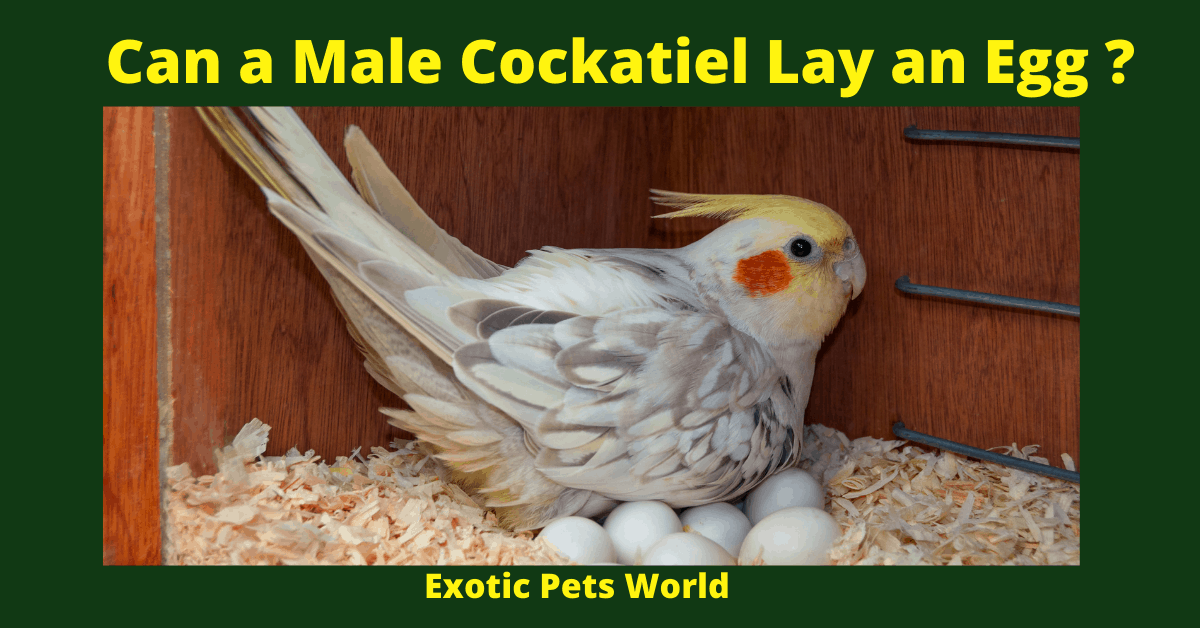Can a Male Cockatiel Lay an Egg?
Can a male cockatiel lay an egg? Male cockatiels do “conceive an offspring” they don’t supply the eggs. At that point, the female stores her eggs into the pocket of the male, where he treats them and broods. The eggs start from a female. Cockatiel females are the solitary ones who can create eggs as guys come up short on the vital organs.

Do Male Cockatiels Sit on Eggs?
While the two guardians will sit on the eggs together from the start, by and large,
they wind up alternating with the male sitting on the eggs during the day and the female around evening time.
The male will monitor the crate when the female is inside. This is the thing that he is doing when he emerges from the crate and acts how he is acting.
Why Do Male Cockatiels Lay Eggs?
While male seahorses do “conceive an offspring” they don’t supply the eggs. At that point, the female stores her eggs into the pocket of the male, where he treats them and broods. The eggs start from a female. Cockatiel females are the solitary ones who can lay eggs as guys come up short on the vital organs.
It’s normal for female flying creatures to laying eggs without a male winged animal is available. … There is no requirement for a male winged animal to be available for a female fowl to laid an egg. Similar to how females ovulate roughly at regular intervals, female winged creatures need to deliver their eggs whether they’re treated. Egg-laying can occur in any breed, it is most common in cockatiels, lovebirds, budgies, canaries, and finches. Egg-laying can start anytime from 5 months to over 10 years of age.

Is My Cockatiel Trying to Lay an Egg?
On the off chance that your female cockatiel (Nymphicushollandicus) is showing bizarre practices or is looking somewhat full, she might be planning to lays an egg – regardless of whether she lives alone. The way that females can store eggs without a male present comes as an astonishment to numerous cockatiel proprietors. Sometimes, exorbitant egg-laying messes well being up.
Physical Signs
Cockatiels sometimes exhibit physical and behavioral clues that indicate eggs are on the way. However, because it only takes a few days for each egg to travel from the ovary to the nest, these clues do not last for very long. Cockatiels carrying eggs weigh more than they normally do, so it is helpful if you weigh your bird regularly to track such weight changes. Sometimes cockatiels appear fuller around their lower abdomen and vent area while they are carrying eggs.
Behavioral Clues
It takes a lot of water to fill developing eggs; so, female cockatiels increase their water intake during the process of egg production.
Additionally, they may assume unusual postures before egg deposition, such as laying outstretched on a perch or the floor of the cage or raising their tail feathers in the air. Some females sing muted songs during this time.
Open the Floodgates Clutch / 8 Eggs
Once a cockatiel lays her first egg, she will lay additional eggs every 48 hours or so thereafter. Clutches vary in size but can include up to eight eggs. As indeterminate layers, cockatiels will produce new eggs to replace eggs that break, disappear or go bad. Some cockatiels produce multiple clutches each year.
Domestic Life / Cavity Nest
Like their domestic descendants, wild cockatiels are cavity nesters. However, unlike pet cockatiels who experience near-constant environmental conditions, their free-flying Australian relatives are subject to conditions that change over the year. This seasonal cycle prompts the production of sex hormones, which in turn produce nesting behavior and mating. The primary cues that stimulate breeding behavior include the increase in daylight and an increase in rainfall. In captivity — where light cycles and water availability remain nearly constant — cockatiels may deposit eggs at any time.

Tempting Trinkets / Encourage Egg Laying
A variety of stimuli can prompt cockatiels to produce eggs in captivity. Sometimes, items in the habitat can stimulate cockatiels to breed or deposit eggs. For example, if you provide your bird with an enclosed nest and fibrous nesting material, such as paper strips or straw, she may produce eggs. Additionally, constant access to bathing water may trick her body into thinking that the spring rains have arrived and it is time to produce eggs.
Calcium Considerations
The calcium demands on an egg-laying female are significant. Accordingly, it is important to ensure that egg-laying cockatiels have access to sufficient calcium. Avoid problems by giving your cockatiel calcium-rich foods such as leafy green vegetables. Provide her with a cuttlebone, which she can nibble at will. Be sure to discuss your birds calcium needs with your veterinarian to ensure she is not likely to develop deficiencies. You don’t want them to have health problems, like egg binding
My Cockatiel Laid An Egg, So Now What?
It is usually quite a surprise to parrot owners when their pet lays an egg, especially if they thought it was a male, or if it lives without a mate. Just like with production chickens laying eggs for consumption, any single bird will become reproductively active and can lay an unfertilized egg during its life in captivity. You can remove the eggs to an incubator.
These suggestions depend on the supposition that you are doing whatever it takes not to raise your fowl. The staff at the Center unequivocally debilitate the rearing of pet parrots, particularly by non-experienced pet proprietors.
If you are attempting to raise, if it’s not too much trouble consider examining this with your avian veterinarian preceding reproducing to find out about the potential for medical issues, monetary cost, and moral reasons why we don’t suggest rearing parrots.
A couple of types of parrots are explicitly dimorphic (you can tell the sex-dependent on the actual appearance) and others are not, such countless proprietors don’t have the foggiest idea whether they have a male or a female.
(We unequivocally suggest getting fowls for testing BEFORE an emergency happens we can undoubtedly decide the sex with a solitary drop of blood.) If you have a male and female or don’t know, it is conceivable that the egg could be fruitful, so when you see an egg, you should eliminate it and supplant it with a phony egg. On the other hand, you could bubble or freeze the egg, however then return it to the home.
It is imperative to restore a type of egg to the home since certain winged animals will proceed to lay eggs, attempting to supplant the lost ones. When the eggs of a grip are completely laid and traded for phony or sanitized eggs, leave them with the flying creatures, in any case, if they are settling them or not, for roughly 3 weeks. At that point, eliminate them each, in turn, all other days until they are no more. This will ideally give the female the time she needs to comprehend that those eggs are not reasonable and won’t bring forth. Much of the time the winged animals will forsake the eggs after a time frame.

While she is laying/settling on the eggs, make certain to speak with your avian veterinarian concerning eating fewer carbs and conceivable nourishing supplementations. Every circumstance might be distinctive depending on history, species, diet, and different factors. Your pet’s PCP may suggest additional calcium, full-range light, protein, or different enhancements during this time.
On the off chance that you consider any to be as depicted above, kindly call your avian veterinarian immediately to plan an arrangement, or possibly acquire your winged creature for a crisis visit. These circumstances can be perilous and dangerous so you ought not to stand by.
Can a Male Cockatiel Sit on an Egg?
The two guardians will sit on the eggs together from the outset, for the most part, they wind up alternating with the male sitting on the eggs during the day and the female around evening time. The male will watch the case when the female is inside. This is the thing that he is doing when he emerges from the crate and acts how he is acting.
For the present, give them as much protection as possible because whenever you can be seen it is an interruption and a danger. It is conceivable they will break the eggs, or not sit on them effectively or they may not be rich.
Be that as it may, let them experience the cycle to get some training. On the off chance that this grasp fizzles, let them attempt once more. From that point forward, eliminate the home box and let them rest from reproducing for a couple of months if the subsequent attempt is a triumph.
Since cockatiels will raise all year in captivity, you must eliminate the container and power them to rest after a fruitful grasp or after several bombed attempts.
Conclusion
Male cockatiels do “conceive an offspring” they don’t supply the eggs. At that point, the female stores her eggs into the pocket of the male, where he treats them and broods. The eggs start from a female. Cockatiel females are the solitary ones who can create eggs as guys come up short on the vital organs.


Thank you for your sharing. I am worried that I lack creative ideas. It is your article that makes me full of hope. Thank you. But, I have a question, can you help me?